
With its helpful and clear videos, intuitive program design, wide curricular compatibility, online grading and scoring, progress tracking and even dedicated test prep resources, My Math Assistant’s digital tools can save parents a lot of time and effort when it comes to teaching Saxon Math and can improve student outcomes in the long run.
What We Like
But watch out for…
What Is My Math Assistant?
My Math Assistant is a web-based service that offers an assortment of tools and resources to help homeschooling parents and teachers more effectively and efficiently teach the Saxon Math curriculum.
Essentially a learning management platform, it offers families access to a comprehensive assortment of videos, practice questions, grading solutions, progress tracking and more to help support lessons.
What Levels Of Saxon Math Does My Math Assistant Support?
My Math Assistant is designed to cover Saxon 3 through Saxon Advanced Math, or roughly grades three through 10-12 or so.
As we’ve noted in our in-depth review of the Saxon Math program, there are a number of different editions of this classic math program being sold online, with many retailers and homeschools still selling and/or making use of its 4th, 3rd and even 2nd editions.
In addition, Saxon is notable for having two versions, its Intermediate Series (Saxon Intermediate 3, 4, 5 and so on) and its Numbered Series (Saxon 5/4, 6/5, 7/6 etc.), and
While the overall approach to teaching math remains broadly similar, the exact lesson structure, questions, tests, question types and order of questions can vary quite a bit between these titles.
Overall, we found that My Math Assistant does a pretty good job at supporting the different versions and editions of Saxon that are out there.
At time of writing, the company’s full suite of videos and automatic grading supported the following Saxon curricula:
| Numbered Series | Intermediate Series |
| Math 3 | Intermediate 3 |
| Math 5/4 (2nd, 3rd) | Intermediate 4 |
| Math 6/5 (2nd, 3rd) | Intermediate 5 |
| Math 7/6 (3rd,4th) | Math Course 1 |
| Math 8/7 (2nd, 3rd) | Math Course 2 |
| Algebra 1/2 (2nd, 3rd) | Math course 3 |
| Algebra 1 (3rd) | |
| Algebra 2 (3rd) | |
| Geometry | |
| Advanced Math | |
It should be noted that the company is continuing to update its series and supports Algebra 1+2 (4th editions from 2009) and Saxon Physics with its automated grading system but (currently) without video lesson support.
It is missing support for the K-3 series, which is somewhat understandable given that these grades do differ quite a bit from the rest of the Saxon series in terms of instruction, approach and style and are generally more manipulative-heavy and scripted than later levels.
Unfortunately, it is also missing support for Calculus, which might be a bit of a disappointment for parents of students interested in taking STEM courses in college and for whom online grading and instructional help could perhaps be very beneficial given the relative complexity of the topics involved.
Interestingly, My Math Assistant also offers parents Saxon placement tests that can help them figure out which level is most appropriate to their student’s needs and abilities, which can be very helpful to homeschools switching into Saxon from another math program.

Parents can provide their email and they will receive a link from the company that takes them to an online placement test.
The placement test is done online and is automatically scored and graded, which is quite helpful and can be a fair time saver for parents.
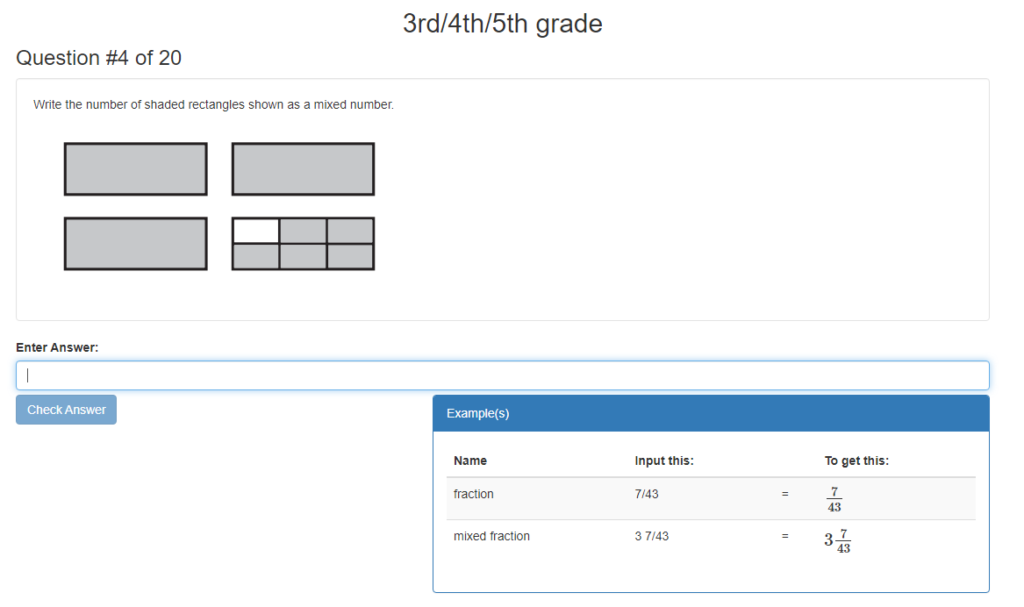
It also sets My Math Assistant apart from most competing platforms, which tend to offer printable PDFs that parents correct and grade themselves.
There is even a built-in instructional video to show students how to properly input their answers, which is kind of thoughtful and can allow students to work a little more independently and without quite as many formatting errors.
That said, as the placement test is online parents will have to keep an eye out to make sure that students don’t cheat and end up at a level far too difficult for them (or answer randomly and end up too far behind).
What Features Does It Include?
My Math Assistant offers a number of features that make it potentially quite useful to homeschooling parents and teachers.
These include:
- Video instruction for each lesson
- Dedicated math facts practice
- Automatic grading and progress tracking
- And standardized test preparation
Video Lessons
For supported Saxon editions and versions, My Math Assistant offers video instruction that provide explanations and examples of various math topics.
These videos directly link to the materials covered in each lesson and are accessible from the student’s dashboard.
They are generally pretty short, often just a few minutes long, but tend to dive right into the topic or skill in question, explaining concepts concisely, clearly and usually with the help of a step by step demonstration or two.
During these videos, the program’s instructor works out sample problems on a digital blackboard, highlighting key terms and providing explanations for concepts from off camera.
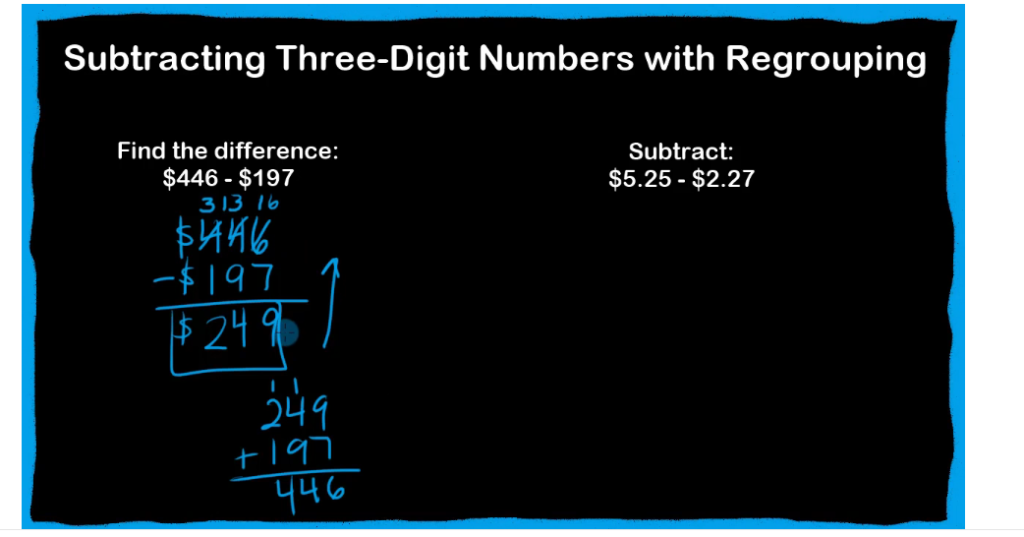
In this way, they are fairly similar in style at least to videos provided by other well-known online educational providers, such as Khan Academy or CTCMath, although they perhaps lack some of the more personal touch provided by hosted videos, such as Nicole the Math Lady and others.
That said, while they perhaps won’t exactly dazzle users with advanced special effects or humor, we feel the videos do tend to do a good job at keeping things focused on the learning and tend to use enough visual drawings and illustrations to make things pretty clear and memorable.
Being so short and to the point, the videos probably won’t completely replace lesson instruction- most parents will probably want to go through lessons first with their student or (with older students) have them go through the concept in depth using the Saxon texts – but they can be an excellent refresher to use before beginning practice.
They also can help clarify things for confused students as they can sometimes break down and explain concepts in a slightly different way and with additional step-by-step examples, which can sometimes help.
Math Facts Practice
Saxon Math is a pretty traditional, procedural math program.
As such, math facts and drill are an important component of its approach, being a good way to help students develop strong skill fluency – i.e. the ability to answer math problems quickly and accurately.
While perhaps a valuable addition to a math curriculum, correcting and grading dozens of math equations each week can be a little time consuming for parents.
To make things a little easier and less tiresome, My Math Assistant has integrated a built-in math fact drill function into the student dashboard.
Essentially a digital quiz-like web app, students work out a problem (either mentally or on a piece of paper) and type their result into a textbook before hitting “submit.”
My Math Assistant then immediately lets a student know if they’ve gotten the answer right or wrong and moves on to the next, tracking performance as it goes with a red/green bar at the top of the page.

The questions are randomly generated by the program, although inspired by and directly linked to each lesson, which keeps the drill fresh and unique.
Math facts practice is usually set by default to about 100 questions, which is quite a bit of practice, although this can helpfully be adjusted from the parent’s dashboard.
Overall, although the math facts section doesn’t provide much in the way of word problems or mental math exercises, we feel they can be a great and very practical way to help students hone and master essential math skills.
Parents should be aware, however, that any program’s real time tracking of student performance (especially when displayed to the student during drill) can be something of a double edged sword.
While it can be very helpful and even motivating for many students who get to see their score rise in real time, some students can become anxious or stressed out by it, especially if they are the type to pressure themselves trying to get a perfect score.
Similarly, its motivational properties can backfire if a student begins to hit a streak of wrong answers, as they see the red bar of incorrect responses begin to gradually creep up on them.
Automatic Scoring and Grading
In addition to periodic tests and investigations, all versions of Saxon Math weave a good deal of practice questions into their lessons.
In addition to direct instruction, for example, lessons in the Numbered series also includes:
- Warm Ups, which are short reviews of mental math, math facts and even basic word problems to help students get into the mindset of what they are learning.
- In lesson practice, which are an assortment of problems that directly touch on the new concepts learned during a lesson’s teaching.
- Mixed practice, which are a mix of questions that cover both new and previously learned material and which form the basis of Saxon’s spiral review.
While broadly similar in overall intent, the Intermediate series changes things up a bit when it comes to practice questions and includes:
- Power Ups, which are essentially similar to the Warm Ups found in the Numbered Series
- In lesson activities, which are essentially in lesson practice problems
- Written Practice, which is somewhat like the mixed practice but also includes Common Core-aligning real world problems and some more challenging problems
- Investigations – which are in-depth explorations of concepts with a few more unique and interesting problems
As those who have used the curriculum over the years can attest, this can sometimes mean quite a bit of work for parents when it comes to going over, correcting, scoring and recording each of these activities.
As part of its platform, My Math Assistant offers an automatic grading component that automates practice to some extent.
For each particular supported edition of Saxon, My Math Assistant has mapped out the answers to each lesson’s practice problems.
Students can therefore work out the problems on their own (again, on paper or mentally in some cases) and input the result into the program.
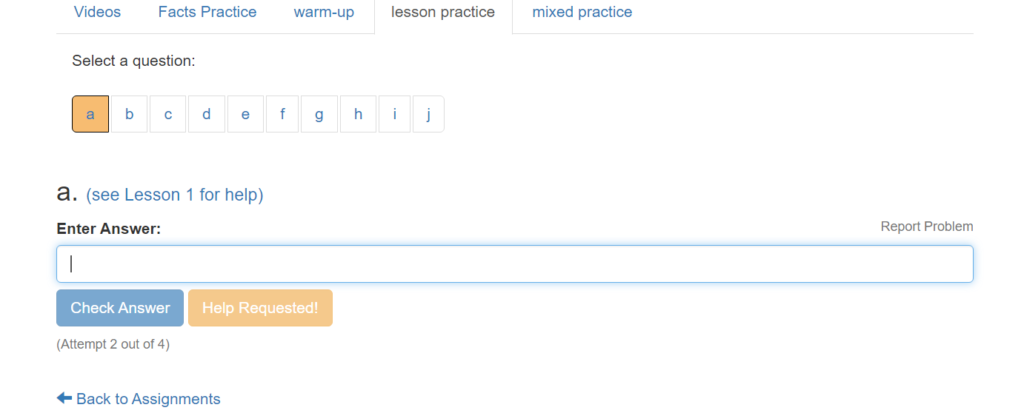
My Math Assistant will then record and score each problem as correct or incorrect and will keep track of student responses.
As the student’s results are corrected, scored and recorded automatically this can be something of a time saver, and can be very useful for busier homeschools.
The system even allows students to flag certain questions, which lets parents know that a student needs some help or extra review with a concept, which is kind of cool.
From their dashboard, parents can then get a fairly comprehensive and detailed overview of student performance, including their overall scores, the percentage of correct to incorrect answers for each set, the results of their fact practice, test results, time spent on each question and more.

Interestingly, My Math Assistant’s reporting also offers parents the ability to track concept mastery.
Saxon generally follows a spiral approach to math learning, introducing concepts a little at a time and revisiting them periodically in increasing depth as the program goes along.
Although it has numerous benefits, this approach can make it a little harder for some parents to keep track of individual skill proficiency and development, especially compared to a mastery program such as Math Mammoth or Singapore that hones skills one at a time and until completion.
By keeping a record of skill development over time, My Math Assistant can give parents deeper insight into a student’s overall math learning and help better identify and prevent the development of any skill gaps over time.
My Math Assistant also lets parents customize these practice problems to a fair extent.
They can, for example, choose to include or exclude certain problems, add custom questions to the mix, or choose to include or exclude tests and investigations from a student’s course load.
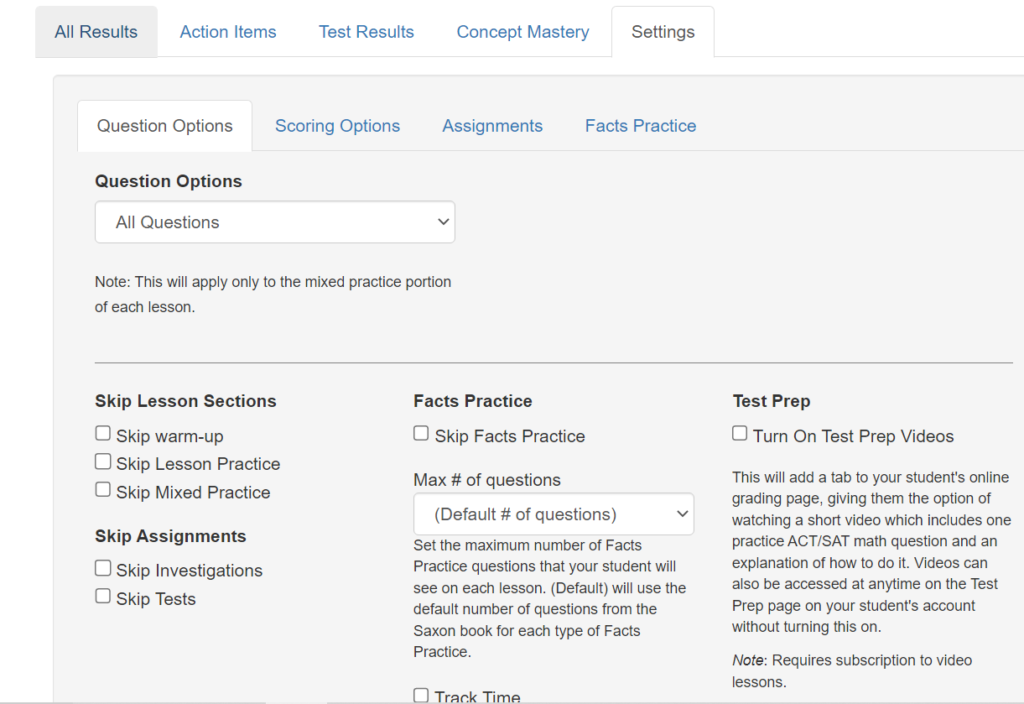
There is also the option to allow multiple attempts on practice and test questions, which can make lessons a little gentler and more approachable, as well as the option to adjust the relative scoring weight of any correct retries.
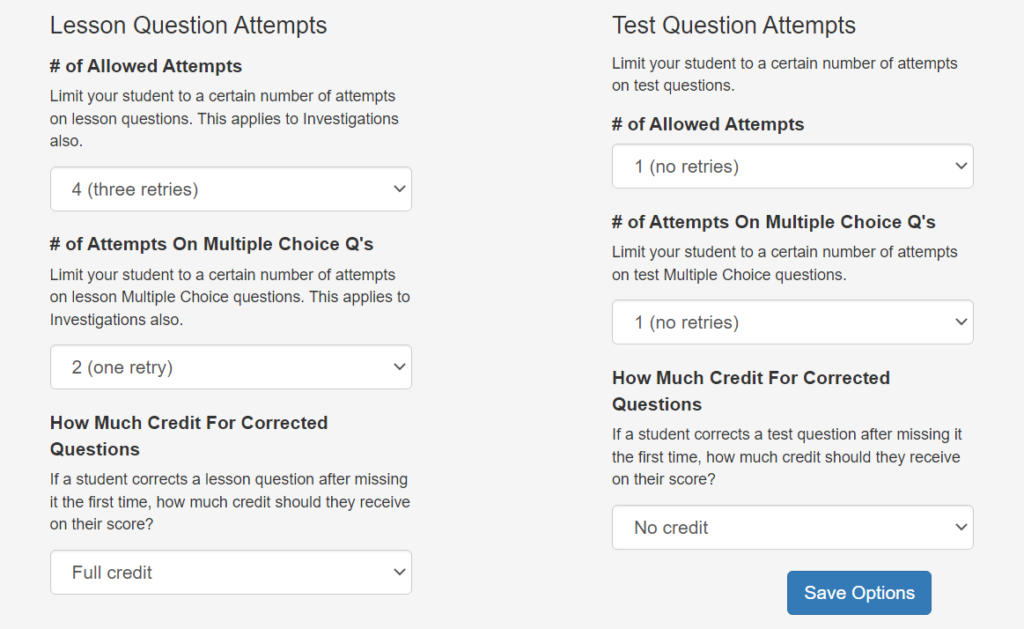
All this can make My Math Assistent a very flexible and customizable learning platform, allowing as it does for parents to easily configure Saxon Math’s ample review and practice to their own particular homeschooling philosophies and needs, which is always something we appreciate.
Parents should note, however, that the questions from each chapter are not included in the program and My Math Assistant really only refers to them by their individual number or letter.
Consequently, it is very important for parents to make sure that they are working from the correct edition and version of Saxon as the program’s answers won’t otherwise correspond to the student’s questions and the whole process won’t really work.
It should also be noted that My Math Assistant doesn’t provide any space for students to work things out online, so they will have to work on more complex problems with scrap paper or in a notebook first before inputting their response.
While working things out by hand can certainly help reinforce learning and aid in retention in the long run when it comes to math, it can be a little awkward at times for some students when sitting in front of a computer or tablet.
Finally, while My Math Assistant does indicate to students whether they have answered a practice or test question correctly or incorrectly and ultimately provides the correct response, it doesn’t really provide the reasoning or work behind the right answer.
As a result, it is still up to parents and students to go over wrong answers in order to learn from any mistakes.
Test Prep
Finally, My Math Assistant also offers parents the ability to add videos relating to standardized test preparation to a student’s dashboard.
The videos are much like the program’s lesson videos in terms of look and style, but focus more around a particular example of a math problem that might be found on the ACT or SAT.

As the instructor explains and demonstrates a particular problem and solution, as well as providing tips and advice for dealing with them in a test situation, students can try their hand at the question and even mark for themselves whether they were successful or not at getting the answer.
While not every homeschool will be interested in integrating these kinds of standardized math questions into learning (particularly those with younger students or those following a more eclectic teaching style), the addition of test prep assistance can nonetheless be helpful and even valuable to many students.
The videos can, for example, gradually and incrementally be added to lessons well in advance of the ACT/SATs (or similar exams), which can help students hone their test taking skills over time, ultimately making the process of prep a lot less stressful for all involved.
Program Look and Feel
Overall, in terms of look and feel, we found My Math Assistant to be very clean and easy to use.
The website uses a lot of white space, avoiding distracting clutter and an overabundance of clickable options and in general everything is pretty clearly labeled and laid out.
This includes the student dashboard, which is pretty focused on guiding students to their lesson work (videos, warm up, practice and so on).
Consequently, there aren’t a lot of ways for even students to get lost on the site, which makes it very easy to use for self-study and practice sessions.
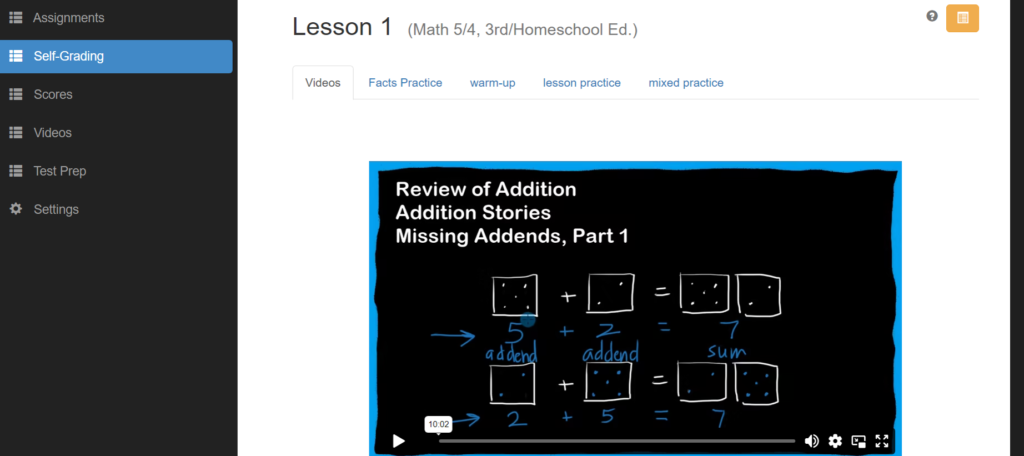
This user-friendly and intuitive design also extends, in our opinion, to the program’s progress tracking and reporting.
We feel that the program lays out the required information in a pretty straightforward and easy to understand manner, avoiding the overuse of complex and distracting graphs and plots in favor of simple and more intuitive percentages and counts.
One thing to note is that by default My Math Assistant allows students to freely browse through previous and future lessons and videos.
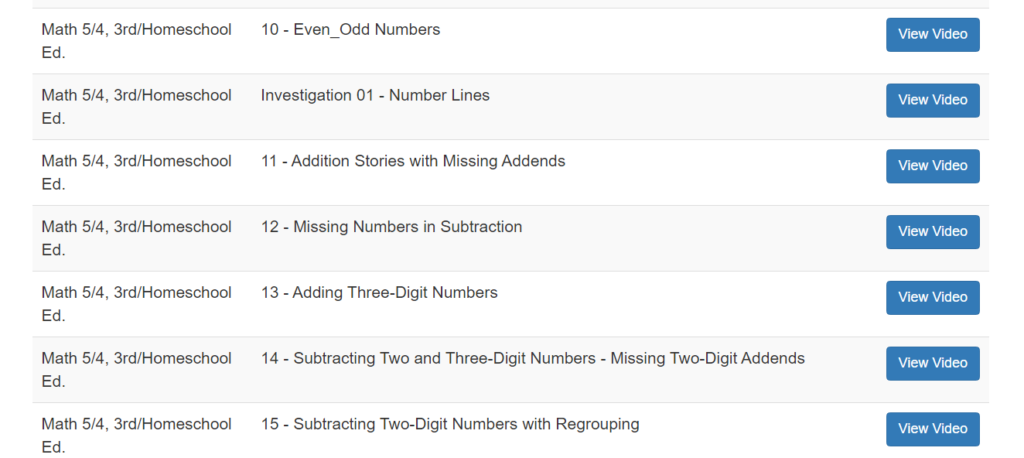
This can have its advantages and disadvantages, as on the one hand students can more easily go back and review previously learned materials on their own but on the other may get distracted.
The parental dashboard does have the option to limit this, however, but it is something that parents will have to select.
How It Works
Getting started and integrating My Math Assistant into lessons is a pretty straightforward process.
Parents first sign up for the platform, selecting whether they would video lessons, automatic grading or both.
Following this, they can then create student accounts for each student learning with Saxon.
Each student account is then linked to a particular book, which as we mentioned previously is a crucial step as its questions and lesson structure really needs to align with the video lesson order and answers in My Math Assistant’s database.

Parents can actually switch the books assigned to a student account at any time, which can be helpful if a parent makes a mistake, decides to switch editions or versions at some point or if a student progresses extremely quickly and advances through the series midway through the year.
It should be noted, however, that only one live version of Saxon is supported per student at any given time and adding another book to a student account will simply deactivate the previous version (although all student data and work is helpfully saved unless purposefully deleted).
Once both parent and student accounts are created, the program is essentially ready to use and students can get to work.
Generally speaking, My Math Assistant is designed to be used alongside regular Saxon Math lessons as it is a time and effort saving learning tool rather than an online math program in and of itself.
A lesson might therefore begin with students logging in and using My Math Assistant’s math fact practice as part of their warm up and drill.
Students and parents (or students on their own if they are capable or old enough) would then go through the relevant Saxon lesson in their coursebooks, exploring the relevant math concepts in-depth and perhaps working through examples together.
Following this, students might be assigned some in-lesson practice or mixed questions.
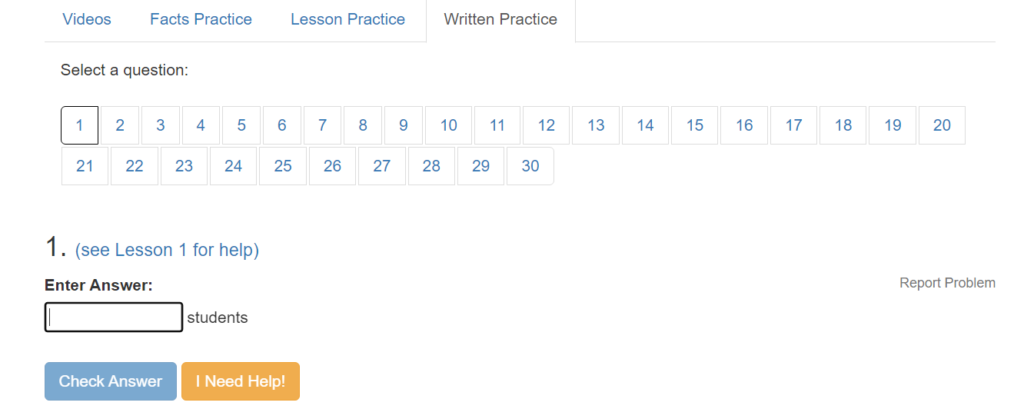
They would then turn to their dashboard, select the relevant tab and start inputting their answers.
These would be immediately scored, graded and recorded, and parents would then be able to go over student results and be able to immediately address any issues students might be having before moving on.
Following the layout of the underlying Saxon edition or volume, every 10th lesson or so students are presented with an investigation to complete and input into the program.
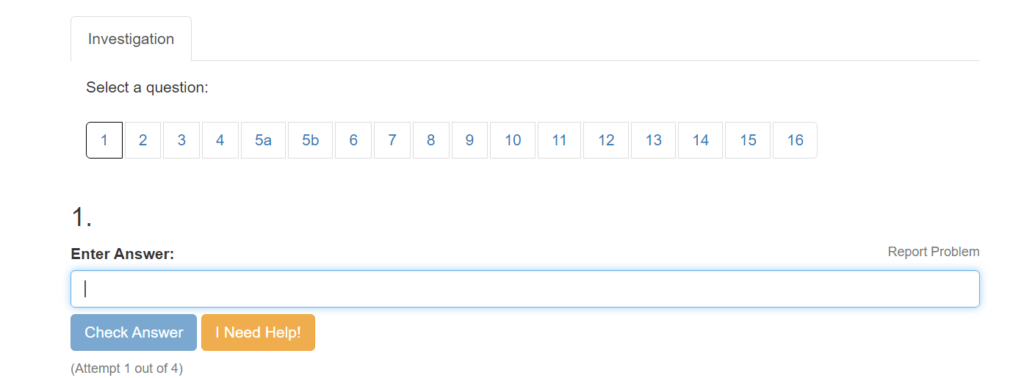
In a similar vein, they can also input their responses from periodic Saxon tests and receive immediate feedback and grading.

Pros and Cons
Pros
Affordable
Starting at just $4.99 a month per student, My Math Assistant is pretty affordably priced and should easily fit most homeschool budgets.
Simplifies the process of teaching Saxon Math for parents and students
With its host of short video lessons, automatically graded practice and testing, test prep videos and in-depth progress tracking and reporting, My Math Assistant offers a lot of features that can save parents and teachers teaching Saxon a good deal of time and effort.
Video lessons can make learning more multisensory, clearer
While perhaps no substitute for a complete lesson, My Math Assistant’s videos are short, to the point and explain concepts in a straightforward, understandable way.
As such, they can be an invaluable resource for review and can even be integrated into lessons to add an additional audio video explanation of a concept, should a student need one.
Very flexible, customizable to fit homeschooling needs
In general, parents have a lot of options to play around with in My Math Assistant.
They can, for example, decide whether to include tests and investigations, choose how many and which practice questions a student should work on, whether to include warm up exercises in each lesson, whether to include the video instruction, whether to include online grading and more.
Consequently, it can be very easy to adjust My Math Assistant to fit any teaching or homeschooling preferences.
Supports a wide range of editions and versions of Saxon
My Math Assistant supports a wide variety of Saxon Math editions, both for the Intermediate and Numbered Series.
Unlike many of its competitors, it even supports the 2nd editions of many levels and, in some cases, new 4th editions.
As a result, it can be used quite effectively by a greater number of homeschools.
Videos are short, clear and to the point
My Math Assistant’s videos are fairly short, explaining concepts quickly and clearly to students with the help of on-screen visuals and drawings.
As such, they aren’t really all that hard for students to sit through or integrate into a student’s lesson plan.
Easy to use, intuitive design
Parents and students should find My Math Assistant is very easy to use and straightforward, as it uses a clean, user-friendly design with minimal clutter and few ways to get lost while using it.
This can make self-study sessions a lot simpler for students and make the process of managing math lessons a lot quicker and less stressful for parents.
Cons
Can make lessons more screen intensive
Using My Math Assistant for math facts practice, video review and in-lesson exercises/testing does mean that students will spend a bit more time sitting in front of a computer each week, which can be an issue to those seeking to limit screen time.
Not available for all Saxon programs
Although it does support most of Saxon Math’s levels, including those from older editions, not every level of Saxon is yet covered by My Math Assistant.
Families looking for help with Saxon Calculus or its K-3 curricula will need to look elsewhere at the moment.
Who Is My Math Assistant Ideal For?
Busy homeschools
My Math Assistant can save parents a lot of time each week when it comes to overseeing review, going over and correcting student practice and recording their scores as these are all automated by the program.
Consequently it can be a very attractive option for busier homeschools and those teaching multiple students at once.
Those unsure of their own math skills
As the program is capable of automatically correcting and grading student work, as well as providing additional help and instruction through its videos, My Math Assistant can take a lot of teaching pressure off of parents who may themselves be a little rusty at math, something that can be particularly beneficial at Saxon’s upper levels.
Homeschools looking to promote self-study and independence in learning
As My Math Assistant automates much of the drill and lesson practice, as well as providing video concept review if necessary, it can allow students to work on the warm up and skill development portion of their lessons on their own through their student dashboard.
This can help students learn to study a little more independently and can let them start to take responsibility for their own learning.
Homeschooling co-ops and pods
My Math Assistant not only provides a host of time-saving and efficient tools for teaching Saxon Math, it also is capable of hosting a number of student accounts, which makes it a potentially useful option for small co-ops and homeschooling pods.
Homeschools on a strict budget
Finally, at well under $100 per year, My Math Assistant offers a number of time-saving online tools and features at a price most families will be able to afford.
Who Is It Not Ideal For?
Those looking for a full online math curriculum
Although it is pretty feature-rich, My Math Assistant is not a full, online self-study math curriculum in and of itself.
It does require the use of Saxon textbooks and materials and will likely need parents to still go through lessons carefully with students before beginning practice.
Those learning Saxon Calculus or K-3
As mentioned, My Math Assistant does not yet support certain levels of Saxon Math, such as its very different K-3 series and Saxon Calculus, which can be an issue for those looking to study these subjects and grades.
Price
Note: Prices correct as of writing, all prices in USD.
Parents have a few ways that they can sign up for My Math Assistant.
They can sign up for video lessons or online grading on their own for $4.99 per month per student.
They can also subscribe to a complete plan that includes both videos and automatic grading for $8.99 per month per student.
In addition, families with more than one student studying with Saxon can purchase a family subscription, which supports up to five students.
Family plans cost around $8.99 per month for video lessons or online grading, and $12.99 per month for both.
As always, parents should check for the latest prices for My Math Assistant, as well as for any discounts or offers that may apply.
Is It Worth The Price?
Overall, we feel that My Math Assistant is not only fairly affordable but also has a lot to offer the right homeschooling families.
The program gives parents teaching Saxon Math at home access to a wide variety of short, clear and to the point instructional videos that can help clarify and solidify a student’s understanding of math concepts.
Further, the program’s online grading and scoring functions allow homeschooling families to more easily and conveniently handle the many math fact practice, questions, spiral reviews and even tests that the Saxon curriculum is known for, saving parents valuable time and effort.
It also enables parents to track student performance in real time, which in turn can give parents valuable and very granular insight into a student’s skill development in math, allowing them to make adjustments in teaching and review if necessary.
Finally, My Math Assistant is a very flexible and customizable program that allows parents a good deal of control over the number, frequency and types of questions, assessments and practice opportunities that students will be given.
As a result, it can very easily be adapted to a greater number of homeschooling styles and preferences.
Bottom Line
Saxon Math is a highly respected and effective math curriculum.
However, whether due to a busy schedule or a perceived lack of skill, some parents can find managing lessons quite challenging.
With its helpful and clear videos, intuitive program design, wide curricular compatibility, online grading and scoring, progress tracking and even dedicated test prep resources, My Math Assistant’s digital tools can save parents a lot of time and effort when it comes to teaching Saxon Math and can improve student outcomes in the long run.

About the Author
David Belenky is a freelance writer, former science and math tutor and a tech enthusiast. When he’s not writing about educational tech, he likes to chill out with his family and dog at home.
